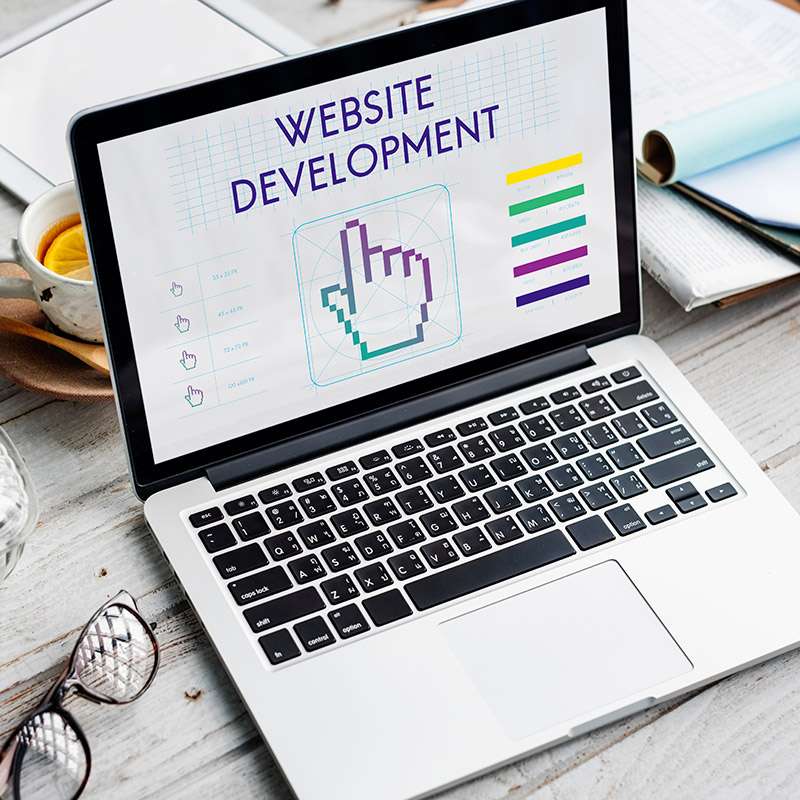Web Development
According to your needs we have designed the web development process in 4 different packages
1.
Informative Website (Static Website)-

Development time: 7 days This web design package is ideal for individuals and small businesses, they are looking to put online their information about their company or business quickly in a cost effective way.
● 1 Domain (Example www.yourcompanyname.com)
● 1GB Hosting Space (Linux Server)
● 10 Email Ids
● Home page + Content and image placement on additional pages.
● Professional theme design following the latest web trends.
● Background image or color of your choice;
● Customized title header, navigation bars & buttons;
● Intuitive navigation to help inexperienced users browse your site
● Clean, clear and concise layout of all copy
● Creative animated punch lines or banner
● Fully owned and royalty free graphics
● Search engine friendly design
● Professional & friendly service
● Flexibility to add new minor specifications at little or no charge
● Technology: HTML5, CSS, Java Script, Flash, CSS3.
● No charge on minor content updates the 1 Year. No hidden cost Recurring Charges: Please contact one of our stores for support
2.
Business Website (Dynamic Website)-

Development time: 15 days This web design package is best for companies who want to promote their business in national and international market.
● 1 Domain (Example www.yourcompanyname.com)
● 1 GB Hosting Space (Linux Server)
● 10 Email Ids
● Home page + Content and image placement on additional pages
● Corporate theme design following the latest web trends
● Background Image or Color of your choice;
● Customized title header, navigation bars & buttons;
● Intuitive navigation to help inexperienced users browse your site
● Clean, clear and concise layout of allcopy
● Creative animated punch lines orbanner
● Fully owned and royalty free Graphics
● Search engine friendly design
● Professional & friendly service
● Completed Feedback or Contact us forms sent to your email directly
● Flexibility to add new minor specifications at little or no charge
● Technology: HTML, CSS, Java Script, Flash
● No charge on minor content updates the three months.
● Social Media Integration
● Language Translator No hidden cost Recurring Charges: Please contact one of our stores for support
3.
Blog Website Development -

Development time: 10 days This web design package is best for companies who want to manage content of the website by themselves and also want to publish blogs for their business marketing.
● 1 Domain (Example www.yourcompanyname.com)
● 30 GB Hosting Space (Linux Server)
● 10 Email Ids
● Home page + Content and image placement on additional more pages
● Database oriented site
● Unlimited category addition option
● Unlimited post addition option
● Corporate theme design following the latest web trends.
● Background image or color of your choice;
● Customized title header, navigation bars & buttons;
● Intuitive navigation to help inexperienced users browse your site
● Website develop on WordPress, drupal or Joomla platform
● Fully functioning content management system
● Creative animated punch lines or banner
● Fully owned and royalty free graphics
● Professional & friendly service
● Search engine friendly design
● Completed feedback or contact us forms sent to your email directly
● Flexibility to add new minor specifications at little or no charge
● Technology: Word Press platform, HTML 5, CSS 3, Java Script, SQL, PHP.
● No charge on minor content updates the three months No hidden cost Recurring Charges: Please contact one of our stores for support
4.
Ecommerce Website (Single Vendor)

Development time: 25 days This web design package is best for companies who want to sell their products and services online.
● 1 Domain (Example www.yourcompanyname.com)
● 100 GB Hosting Space (Linux Server)
● 50 Email Ids
● Home page + Content and image placement on additional pages
● Corporate theme design following the latest web trends
● Intuitive navigation to help inexperienced users browse your site
● Clean, clear and concise layout of all copy
● Creative animated punch lines or banner
● Fully owned and royalty free Graphics
● Search engine friendly design
● Professional & friendly service
● Payment gateway integration
● Completed order forms sent to your email directly
● Technology: Open Cart , Magento, HTML, CSS, Java Script, Flash, ASP.NET, SQL Server 2005, PHP/MySQL
● Flexibility to add new minor specifications at little or no charge
● No charge on minor content updates the three months
● Go live testing and implementation No hidden cost Recurring Charges: Please contact one of our stores for support
Website Development
Content is King
In this digital era, every organization must have a good website. However, what makes a website truly thrive? The answer is simple: content.
A great website has engaging and compelling information that speaks to your target audience. It should be the driving force behind your website development efforts. Having an understanding of the kind of content you want to offer will determine how your website will look and how it will work for users.
Constructing a site without a concrete content plan can be tough and time consuming, but don’t worry! If you want to create a website that converts, you might consider engaging an experienced web developer.
Do you need help in finding qualified web developers near me? You may kick start your journey towards having a standout online platform by simply typing “web developers near me” into the search bar of any internet browser.
Why is content important?
To survive, high-quality content is needed on your website, just like a powerful engine is needed by a car. However, it is the content that drives results.
Consider your website as a salesperson who will not stop working. To convert visitors into buyers, your content must be informed, entertaining, and convincing. This is how website content helps your business succeed:
Clarity and Confidence: Engaging content tells the story of your brand, effectively describes what you are selling, and puts you forward as an expert in your industry, thereby breeding confidence.
Search Engine Magic: Well written content laden with relevant keywords are to search engines what glowing neon signs mean to potential customers looking for something. This enhances the increased visibility of your site, making it visible to more qualified leads who are searching for what you have.
The Knowledgeable Guide: When writing marketing materials or creating educational pieces about their products or services, businesses should always consider the pain areas and issues of their target market. Informative blog posts, engaging videos, and FAQs make you look like a useful resource that keeps people interested in coming back.
Action Stations: Instead of merely informing them, instruct them what to do next!
Looking for a Website Powerhouse?
Content is king, but it can be time taking to develop. We at The Mobile Hub will ensure you get through this! There are numerous website management services available from us that will assist in enhancing your online engine.
Website Development: Our team of professional developers can create a breathtaking and user-friendly website that represents your brand and products exactly.
Web Developers Near You: Throughout the development process, our team of experts work with you so that your dream is realized.
Website Management Services: Do not let your site grow stale. Our ongoing management services keep content fresh, security updated and running smoothly.
We are the top website development company in Australia, and we love helping companies achieve their online objectives. Call us now for a free consultation, and together, we can make your website into a powerhouse!
Content and SEO are mutually beneficial (ask our store for seo/smo services)
Creating a strong internet presence is essential for every contemporary company. Nowadays, merely owning a website is insufficient. High-quality content that captivates, engages, and eventually turns visitors into customers is essential for true success. This is the real shining moment for the potent mix of Search Engine Optimisation (SEO) and website creation.
Content as your SEO Lighthouse
Imagine search engines like Google being lighthouses that guide ships (websites) through an expansive ocean (internet). Content acts as a light to your website, showing its importance and providing search engines with the information they require to determine and rank it.
By prioritizing SEO-friendly content, you are essentially constructing a strong lighthouse that attracts search engines and, eventually, prospective clients. Here’s why this strategy is a win-win:
Improved search rankings: Well-optimized content makes your website more visible across Search Engine Results Pages (SERPs). When people search “web developers near me” or “website development Sydney”, chances are that your site would be on the first page, hence bringing quality traffic to you.
Elevated User Experience: An improved user experience is one that has good content, not just for search engines but also for users. Therefore, through creating captivating and informative content about web development, web coding or website development Annerley, West End or Gladstone australia you imbibe a thought leader tag and an authentic resource person which builds your credibility while encouraging people to explore your offerings.
Research is Important: Get deep into the shoes of your target audience. What questions do they have about website development company or website developers Brisbane? Use Google Keyword Planner or industry magazines to find frequently used terms online.
Is your web development business ready to grow? Our team at The Mobile Hub is here to help! Range from SEO-friendly content through visually attractive yet functional websites we provide.
Content should be the foundation of design
If a website is to be successful, it must have a well-defined plot, just as any good story does. Before you begin website development, you should understand the objectives of your application. What problem do you want to resolve? Who is your audience? Answering these questions will help you identify the most relevant information that would keep people interested.
Develop Your Content Journey
Think of content on your website like a roadmap. This guides users through the website so they can complete tasks and interact with various features. Take an inventory of any existing content, such as website copy, marketing materials, or competitor apps that you have. Is your message clear and coherent? Are there any gaps or areas needing further explanation?
You may create a clear sitemap outlining how your app is structured by organizing your content. This roadmap saves time spent on design dead ends. So picture this: with the content-oriented sitemap in hand, consider your team working seamlessly together to create an intuitive user experience. Like puzzles, every piece of information, such as product descriptions, tutorials and user onboarding, fit into each other, leading users along the interface.
Content Modelling & The Blueprint Before Building
Assuming you have done a sitemap and wireframes before. In that case, why is it that I need a content model? Because you are on the right track! The content model takes it a step further by defining precisely what specific content goes onto each page and how it relates to the overall user experience in relation to Content Management Systems (CMS).
Think of a content model as an app architecture roadmap. A well-structured content model, like strong foundations for a building, makes sure that an application is easy to use and provides information.
Whether you want to create a breathtaking template or an app engine with the help of a backend designer, software development companies in Australia are highly experienced. Are you searching for Python Web Developers in Australia? We specialize in different programming languages so that you can select the best match for your project.
How content modelling supports your CMS design work
Suppose trying to build a house without any blueprint or a plan. It may seem possible, but you will soon find yourself dealing with structural problems, wasted materials, and a disorderly end product. The same kind of chaos may follow when developing a site without a content model.
A good CMS is underpinned by content modelling, which informs how your vision can be brought to life through an interactive user experience. This will help you as the website owner to truly come up with the detailed structure of the content that is put together in its various forms.
A Smooth Flow from Model to CMS
Your content model is similar to a dissection of what makes up your website content in detail, and it focuses on what information would be used and how it could be organized. This thorough planning eventually results in having Collections and Fields within your CMS.
This property is attractive because of its ability to create nested structures. According to the reference material, “Genre”, “Author”, and “Publisher” are among the elements included in the metadata. These would not be single fields in the “Books” Collection. Instead, content modelling allows you to create separate collections for Genres, Authors and Publishers. The Books Collection can then employ reference fields to link to their entries in these sub-collections.
Content is the key to Website Success.
The value of content modeling goes beyond organization alone, but it makes you put your content first before getting into design. Taking time to plan out your content requirements will give you a clear insight into what purpose the website should serve and who mainly would be using it . This means that every design decision will be aligned with your content strategy thereby resulting in a site that resonates with users.
Who creates content? Building a Dream Team (or Not)
An ideal situation would be one where all your writers are professionals who understand your brand’s voice and its target demographic. Such people can be called wordsmiths that can create captivating write-ups that inform as well as entertain the readers. Unfortunately, this is not always the case especially for small organizations.
The customer may be forced to generate content. While some clients are excellent at writing, others may find it challenging. Hence, the quality of existing material (if any) must be evaluated during the initial project audit.
Bridge the Quality Gap
No matter who prepares the material, don’t hurry into design before you have solid content architecture in place. For instance, a website designed without a clear vision on its contents will result in frustration and disappointing outcomes.
If a client cannot write or has no money for hiring a permanent writer; fit content development into your project scope. Otherwise, outsource the whole task to an expert writer.
Educating the Client About the Importance of High-Quality Content
However, what happens in cases where client overestimates their writing skills endeavours and insists on being at the forefront? This is when gentle guidance comes into play.
Display competing websites that have great contents. Bring out how concise their writings are, how powerful their calls for action are, and how they strategically use some keywords to enhance search engine optimization (SEO) efforts.
Remember, a successful entrepreneur may not know the importance of good content. Educating individuals with tenderness and honor could help them realize the significance of having high-quality articles for return generating or brand visibility purposes.
Enthralling Content - The Soul Of Your Website
What brings visitors to your website and how do you keep them there? Every website without an appealing context seems like a beautiful mansion with nothing inside.
To create a user-friendly experience, content development should be given priority in the early stages. This enables the design to align perfectly with your content, highlighting vital information and functions. Suppose a sculptor would shape a masterpiece from a well chosen stone.
In Australia, where digital presence is critical, website development company follow this principle. Their expertise lies in generating engaging content that informs, educates and resonates with your target audience. So invest in good content – it is all about building a functional website that actually